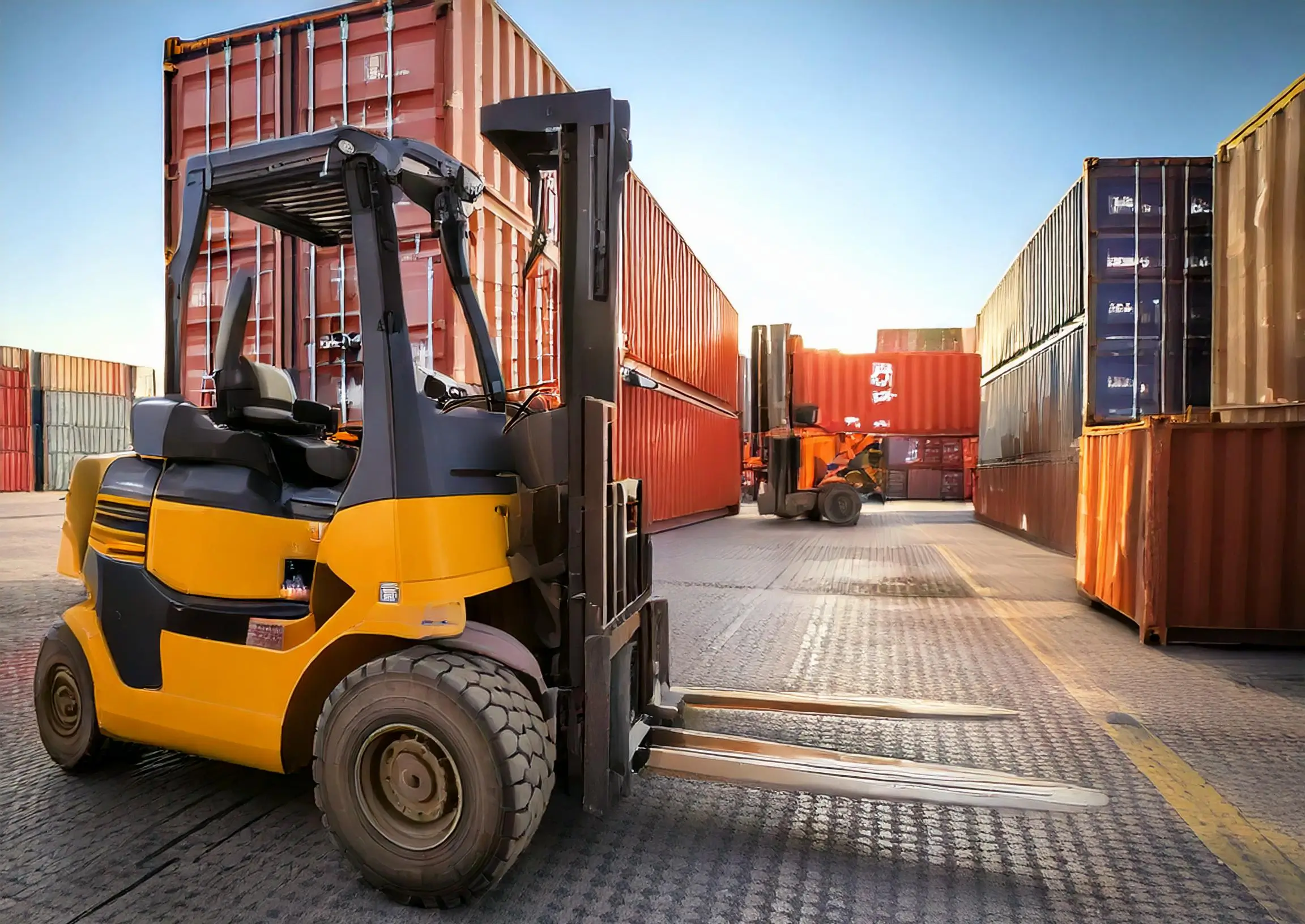Introduction
Moving shipping containers efficiently is crucial in logistics and supply chain management. Whether you’re in a bustling warehouse or a busy shipping yard, the ability to transport containers swiftly can significantly impact productivity and cost-effectiveness.
Among the most popular options for this task are dollies and forklifts, each offering unique advantages that can make a big difference in how you handle your container moving needs.
In this blog, we’ll dive into a friendly comparison of dollies and forklifts. We’ll look at their features, strengths, and weaknesses, helping you decide which option might be the best fit for your specific operations.
Whether you’re maneuvering in tight spaces or moving heavy loads over long distances, understanding these tools will empower you to make informed choices that enhance your efficiency and effectiveness in container handling. Let’s get started!
Understanding the Basics
What is a Dolly?
A dolly is a wheeled platform designed to facilitate the movement of heavy loads, particularly shipping containers, over short distances. Think of it as a handy tool that makes it easier to shift those bulky boxes without needing heavy machinery.
Dollies come in various designs, but they typically feature a flat surface with wheels, allowing for smooth navigation across different terrains.
When it comes to shipping containers, there are several types of dollies you might encounter:
- Standard Dollies: These are ideal for light to medium-weight containers and are commonly used in warehouses and loading docks.
- Heavy-Duty Dollies: Designed to handle heavier loads, these Heavy-Duty dollies are robust and built to withstand challenging environments.
- Steerable Dollies: These have swivel wheels that allow for better maneuverability, making them perfect for tight spaces where precision is key.
- Modular Dollies: These can be customized and expanded depending on the specific needs of the load or environment, providing flexibility for various applications.
What is a Forklift?
A forklift is a powered industrial vehicle equipped with a pronged device in front that can lift, carry, and move materials.
Forklifts play a vital role in logistics and warehouse operations, particularly for handling heavy loads, including shipping containers.
They are the workhorses of the material handling industry, making it possible to lift and transport containers efficiently and safely.
There are several types of forklifts commonly used for container handling:
- Counterbalance Forklifts: The most common type, these forklifts have weights at the back to counterbalance the load at the front. They’re great for lifting containers in open spaces.
- Reach Trucks: These are designed to extend the forks outwards to reach loads stored high up, making them perfect for warehouse racking systems.
- Pneumatic Tire Forklifts: Ideal for outdoor use, these forklifts can handle rough terrains and are commonly used in shipping yards and construction sites.
- Straddle Carriers: These are specialized forklifts designed specifically for moving shipping containers, allowing operators to lift containers from the ground and transport them without needing a truck.
Both dollies and forklifts serve essential functions in moving shipping containers, but understanding their differences is key to selecting the right tool for your specific needs.
Comparative Analysis: Dolly vs. Forklift
Maneuverability
When it comes to maneuverability, dollies truly shine in tight spaces. Their compact design allows them to navigate through narrow aisles and crowded areas with ease, making them perfect for use in warehouses or loading docks where every inch counts. Dollies can be easily pushed or pulled by hand, offering quick adjustments on the fly.
On the other hand, while forklifts have impressive lifting capabilities, they can be cumbersome in confined spaces. Their larger size and turning radius can make them less practical for intricate maneuvers, especially in facilities with limited space. However, forklifts are designed for more extensive outdoor operations, where their power can be fully utilized.
Load Capacity
Load capacity is where forklifts take the lead. Depending on the model, a forklift can lift several tons, making it ideal for transporting heavy shipping containers. Many forklifts can handle loads ranging from 3,000 to over 50,000 pounds, ensuring that even the heaviest containers can be moved safely.
Dollies, while capable of carrying substantial loads, generally have a lower weight limit compared to forklifts. Heavy-duty dollies can handle loads in the range of 2,000 to 10,000 pounds, depending on their construction. While they’re perfect for lighter containers, they may not be suitable for the heaviest shipping loads.
Ease of Use
In terms of ease of use, dollies are generally more user-friendly. Most people can operate a dolly with little training, making them accessible for various staff members. Their straightforward design means that no special skills are required, which can save time during operations.
Conversely, forklifts require more extensive training and certification to operate safely. While they offer greater lifting capabilities, the complexity of driving a forklift, including understanding load balance and maneuvering in tight spots, means that staff need proper training. This additional time investment can impact operational efficiency.
Cost-Effectiveness
From a cost perspective, dollies typically have a lower initial investment compared to forklifts. They require less maintenance and have fewer operational costs, making them an attractive option for businesses that handle lighter loads or have tight budgets.
Forklifts, while more expensive to purchase and maintain, can provide significant value for businesses that regularly transport heavy containers. Their durability and versatility in handling various load types can justify the investment, particularly for larger operations that require efficient and powerful equipment.
Safety Considerations
Safety is a critical factor in any equipment choice. Dollies are generally safer for use in confined spaces, as they have a lower risk of tipping over or causing accidents. However, operators still need to be mindful of proper loading techniques to avoid injuries.
Forklifts, while powerful, come with higher safety risks, particularly if operated improperly. They can tip over if the load is not balanced or if they make sharp turns at high speeds. Modern forklifts come with various safety features, such as load alarms and stability systems, but the potential for accidents remains a concern.
Situational Analysis: When to Use Each Equipment
Short-Distance Moves
For short-distance moves, especially within warehouses or loading docks, dollies are often the go-to choice. Their compact design allows them to maneuver through tight spaces easily, making them ideal for quickly moving containers from one spot to another without much hassle. Dollies can be easily operated by hand, allowing for quick adjustments and repositioning as needed, which is essential in busy environments.
Forklifts, while certainly capable of moving containers, can be overkill for short distances. Their larger size and the requirement for operator certification make them less practical for simple tasks like repositioning containers within a confined area. Thus, for tasks that involve frequent short-distance moves, dollies can help streamline operations and enhance overall efficiency.
Long-Distance Transport
When it comes to long-distance transport, particularly outside the confines of a warehouse, forklifts come into their own. They offer the power and capacity needed to move heavy shipping containers over more extended distances, especially when integrated with dollies or trailers. Using dollies in conjunction with forklifts can create a versatile system where dollies handle the initial short-distance moves, and forklifts take over for longer hauls.
Dollies can be used for preliminary transport within a loading area or yard, then connected to a larger transport system for the long haul. This combination allows for seamless transitions and maximizes efficiency while ensuring that heavy loads are handled safely and effectively.
Rough Terrain and Outdoor Conditions
In rough terrain or outdoor conditions, the choice of equipment becomes even more critical. Forklifts excel in these situations, especially models designed for rugged environments. They can navigate uneven surfaces, dirt, and gravel with ease, making them suitable for construction sites or areas without paved paths. Their power and stability allow them to transport containers safely, even in challenging conditions.
On the flip side, while some heavy-duty dollies are built to handle rough terrain, they may not perform as reliably as forklifts in more extreme conditions. Dollies can be advantageous for moving containers over short distances in less challenging outdoor scenarios, but when it comes to navigating uneven surfaces or transporting heavy loads over longer distances, forklifts remain the better choice.
Specialized Dolly Options for Forklift Compatibility
When moving large and heavy containers, forklift-compatible dollies can be a strategic asset, combining the high capacity and strength of forklifts with the maneuverability and stability of a dolly.
These hybrid solutions support a smooth transfer process, particularly in environments where additional stability is beneficial, such as on uneven surfaces or with oversized loads.
Specialized dollies that can attach seamlessly to forklifts offer flexibility, especially for operations needing adaptability for varied container weights and handling conditions.
TriWich’s HitchWich ForkWich have this capability. They’re engineered specifically to handle heavy, large containers by combining the maneuverability of a dolly with the lifting power of a forklift.
This design helps ensure both stability and efficiency, making it ideal for situations where containers need to be moved in tighter spaces or rugged conditions.
This option can significantly enhance flexibility and ease in container transport.
Conclusion
In summary, both dollies and forklifts play vital roles in the efficient movement of shipping containers, each with its unique strengths. Dollies are perfect for short-distance tasks, particularly in tight spaces like warehouses and loading docks, where their maneuverability and ease of use can significantly enhance operational efficiency. On the other hand, forklifts are the heavy hitters, designed for long-distance transport and rough terrain, providing the power and stability needed to move heavier loads safely and effectively.
Frequently Asked Question
What is the primary difference between a dolly and a forklift for moving shipping containers?
Dollies are typically used for short-distance movements in tight spaces, providing excellent maneuverability and ease of use. Forklifts, on the other hand, are designed for heavier loads and long-distance transport, offering greater lifting capacity and stability.
Which option is more cost-effective for moving containers?
While dollies often have a lower initial investment and maintenance cost, forklifts can be more efficient for larger operations that require moving heavy containers over longer distances. The best choice depends on the specific needs of your operation.
Are dollies safe to use in outdoor environments?
Dollies can be safe for outdoor use, especially if designed for rough terrain. However, care should be taken to ensure they are stable and properly suited for uneven surfaces. Forklifts are generally better equipped for outdoor conditions, especially in rugged settings.
What training is required to operate a dolly versus a forklift?
Dollies are usually straightforward to operate and may not require formal training, while forklifts typically require specific training and certification due to their complexity and the safety risks involved in their operation.
Can dollies and forklifts be used together in a logistics operation?
Yes! Combining dollies with forklifts can enhance efficiency. For instance, dollies can be used for maneuvering containers within confined spaces, while forklifts can handle the heavy lifting and transportation of those containers over longer distances. This strategic use of both tools can optimize workflow in a warehouse or shipping environment.

